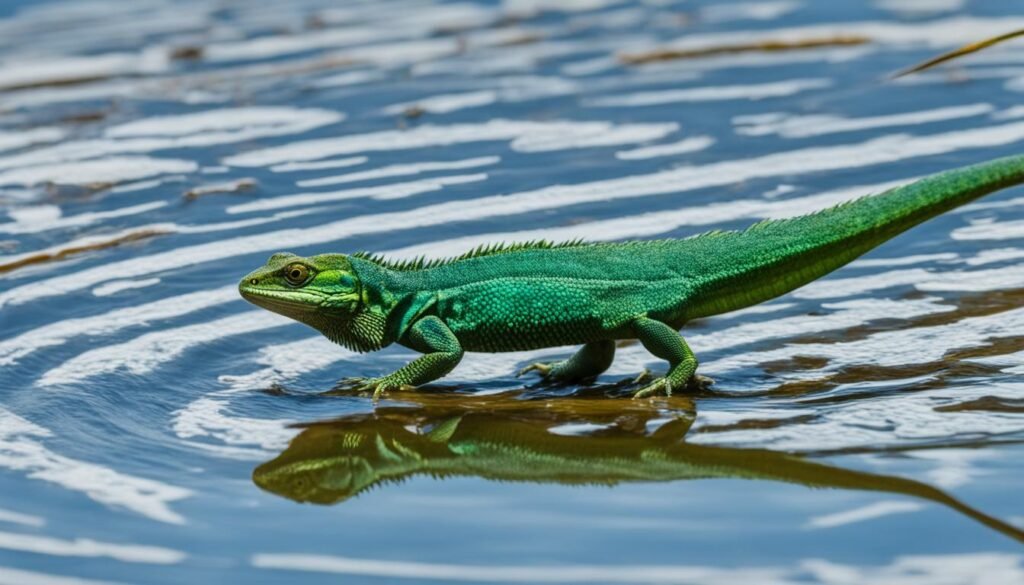Did you know that the basilisk lizard, also known as the Jesus Lizard, can run on water? This incredible reptile found in Central America and South America has the ability to sprint across the surface of lakes and rivers, defying gravity and capturing the awe of onlookers. But the basilisk lizard’s impressive skills don’t stop there. In this article, I will share with you some fascinating facts about the basilisk lizard, including its speed, habitat, and diet.
Key Takeaways:
- The basilisk lizard, also known as the Jesus Lizard, can run on water, making it one of the most unique creatures in the animal kingdom.
- These lizards have adaptations that enable them to thrive in their natural habitat, including saw-like teeth for capturing prey and hind legs that are longer than their front legs for fast running.
- Basilisk lizards inhabit tropical forests near water sources and can be found throughout Central America and parts of South America.
- They have a diverse diet that includes insects, flowers, and small vertebrates like snakes, birds, eggs, and fish.
- The population of basilisk lizards is currently stable, and they are classified as Least Concern on the IUCN Red List.
Common Basilisk Species
The common basilisk, scientifically known as Basiliscus basiliscus, is a species of basilisk lizard that is widely found in Central America and parts of South America. It is often referred to as the Jesus Christ lizard due to its ability to run on the surface of the water. This species is characterized by its large size, high fin-like crest, and brown and cream coloration. It is an excellent climber, swimmer, and runner, making it one of the most unique lizards in the world.
| Species | Common Name | Scientific Name | Size | Coloration |
|---|---|---|---|---|
| Basiliscus basiliscus | Common Basilisk | Basiliscus basiliscus | Up to 3 feet | Brown and cream |
Appearance and Adaptations
The common basilisk lizard possesses remarkable adaptations that contribute to its ability to thrive in its natural habitat. These adaptations enable it to excel in both land and water environments.
Mouth and Teeth
One of the notable adaptations of the common basilisk lizard is its large mouth with saw-like teeth. This dental structure allows the lizard to effectively capture and consume its prey, which primarily consists of insects, small vertebrates, and plant matter.
Leg Length
The hind legs of the common basilisk lizard are longer than its front legs, giving it a unique advantage in mobility and agility. This anatomical feature enhances its running abilities, enabling it to swiftly navigate its environment and escape potential threats.
Feet and Water Running
The feet of the common basilisk lizard are equipped with specialized flaps of skin. These flaps enable the lizard to catch tiny air bubbles while running on water, resulting in its impressive ability to traverse the water’s surface. This adaptation, known as “water running,” supports the lizard’s evasion and survival strategies.
By combining its saw-like teeth, long hind legs, and specialized feet, the common basilisk lizard exemplifies the remarkable adaptations that allow it to thrive and excel in its unique ecological niche.
Habitat and Distribution
Common basilisk lizards are primarily found in the tropical dry lowland forests of Central America, as well as wet and moist forests near streams, lakes, and rivers. They have a wide distribution range, spanning from southwestern Nicaragua to northwestern Colombia on the Pacific side, and from central Panama to northwestern Venezuela on the Atlantic side. In Costa Rica, they are predominantly found on the Pacific side of the country.
| Country | Distribution |
|---|---|
| Nicaragua | Southwestern part on the Pacific side |
| Colombia | Northwestern part on the Pacific side |
| Panama | Central part to the northwestern part on the Atlantic side |
| Venezuela | Northwestern part on the Atlantic side |
Behavior and Lifestyle

Common basilisk lizards are fascinating creatures known for their unique behavior and lifestyle. As solitary and diurnal creatures, they exhibit specific characteristics and habits that are adapted to their natural environment. Let’s delve deeper into the behavior and lifestyle of basilisk lizards.
Foraging and Basking
During the day, basilisk lizards spend their time foraging for food and basking in the sun. They have a diverse diet, which includes insects, flowers, and small vertebrates like snakes, birds, eggs, and fish. This omnivorous diet allows them to obtain the necessary nutrients for their survival. After a satisfying meal, they often seek warmth and comfort by basking in the sun. This behavior helps regulate their body temperature and aids in digestion.
Nocturnal Behavior
At night, basilisk lizards retreat to the safety of trees to rest. They are known to sleep in trees as high as 20 meters from the ground, away from potential predators. This nocturnal behavior ensures their safety while they rest and rejuvenate for the following day.
Escape Tactics
When threatened, basilisk lizards have ingenious escape tactics that showcase their remarkable agility. Their first instinct is to head towards the nearest body of water. Using their incredible ability to run on water, they sprint across the surface, utilizing their hind legs and holding their forelegs against their bodies. This unique behavior helps them evade predators and reach safety quickly.
Expert Climbers and Swimmers
Basilisk lizards are highly proficient climbers and swimmers. With their sharp claws and strong limbs, they navigate through trees with ease, making use of their arboreal environment. Their swimming abilities allow them to traverse rivers, lakes, and streams in search of suitable habitats and food sources.
| Behavior | Description |
|---|---|
| Foraging | Common basilisk lizards spend their time searching for food, which includes insects, flowers, and small vertebrates. |
| Basking | They enjoy basking in the sun, regulating their body temperature and aiding in digestion. |
| Nocturnal Rest | At night, basilisk lizards sleep in trees, away from potential predators. |
| Escape Tactics | When threatened, they escape by running on water and reaching safety. |
| Climbing | Basilisk lizards are exceptional climbers, utilizing their sharp claws and strong limbs to navigate trees. |
| Swimming | They are adept swimmers, allowing them to move through bodies of water in their habitat. |
Speed and Running on Water
One of the most impressive abilities of the basilisk lizard is its speed and the ability to run on water. It can run at an average speed of 24.1 km/h (15 mph) on land, which is just slightly slower than its speed on water. When running on water, basilisk lizards use their large hind feet with special flaps of skin to create air pockets that keep them from sinking. Younger lizards can run farther on water, while adults can only cover a few meters before sinking.
| Speed Comparison | |
|---|---|
| Land Speed | 24.1 km/h (15 mph) |
| Water Speed | Slightly slower than land speed |
In their natural habitat, basilisk lizards rely on their remarkable speed for various purposes. They use it for hunting, escaping from predators, and navigating their environment. The ability to run on water provides them with an extra advantage and allows them to evade threats by quickly fleeing across lakes, rivers, and streams.
Diet and Nutrition
The diet of basilisk lizards is incredibly diverse, allowing them to obtain the necessary nutrients to survive and thrive in their habitat. These omnivorous creatures have a varied menu that includes:
- Insects: Basilisk lizards feed on a variety of insects such as beetles and dragonflies. These small creatures provide a significant portion of their diet and are a vital source of protein.
- Flowers: Believe it or not, basilisk lizards also include flowers in their diet. The blossoms provide them with essential nutrients and serve as a valuable food source.
- Small Vertebrates: Basilisk lizards are opportunistic feeders and have a taste for small vertebrates. This includes snakes, birds, eggs, and even fish. Their ability to capture and consume these prey items helps ensure a well-rounded diet.
By incorporating such a diverse range of food sources into their diet, basilisk lizards can maintain optimal health and thrive in their natural habitat. It is this adaptability in their feeding habits that contributes to their success in the animal kingdom.
The Role of Diet in Basilisk Lizard Survival
The diverse diet of basilisk lizards plays a crucial role in their overall survival. Insects provide them with essential proteins, while flowers offer additional nutrients. By including small vertebrates in their diet, basilisk lizards can fulfill their nutritional requirements and maintain their agility and strength.
| Food Sources | Nutritional Benefits |
|---|---|
| Insects | High protein content, essential for growth and muscle development. |
| Flowers | Provide various vitamins and minerals critical for overall health. |
| Small Vertebrates | Source of fats, calcium, and other crucial nutrients for energy and bone strength. |
This table highlights the nutritional benefits of the different food sources consumed by basilisk lizards. By incorporating a mix of protein, vitamins, minerals, and fats into their diet, these lizards thrive in their natural ecosystem.
Reproduction and Life Cycle
Common basilisk lizards are fascinating creatures when it comes to their reproduction and life cycle. These lizards are polygynous, meaning that males mate with multiple females during the breeding season. This breeding season typically occurs in March, when the lizards engage in courtship displays to attract mates.
Once the female basilisk lizard is ready to lay her eggs, she digs a hole in the ground and constructs a nest. The female then lays clutches of 10-20 eggs in the nest and covers them with soil, providing protection and insulation for the developing embryos.
The eggs of the common basilisk lizard have an incubation period of approximately three months. During this time, the female ensures that the nest remains moist to support the growth and development of the embryos. The maternal care exhibited by the female during this period is crucial to the survival of the offspring.
Once the incubation period is complete, the baby basilisks hatch from their eggs. They emerge fully developed and independent, capable of fending for themselves from the moment they enter the world. This early independence allows the young basilisks to disperse and explore their environment, adapting to their surroundings and developing their own territories.
Overall, the reproduction and life cycle of common basilisk lizards showcase the resilience and adaptability of these remarkable creatures. Their ability to reproduce successfully and ensure the survival of their offspring contributes to the maintenance of healthy basilisk lizard populations in their natural habitats.
Conservation Status and Population

The population size of common basilisk lizards is currently unknown, but there are no major threats to this species. They are locally common and widespread throughout their range, indicating a stable population. As a result of their stable numbers and lack of significant threats, the common basilisk lizard is classified as Least Concern (LC) on the International Union for Conservation of Nature (IUCN) Red List.
While the exact population size remains uncertain, the common basilisk lizard continues to thrive in its natural habitat. Ongoing conservation efforts are essential to ensure the protection and preservation of their ecosystems, ensuring the continued survival of this fascinating reptile.
Threats to Basilisk Lizard Population
The common basilisk lizard population is currently not facing any major threats. However, habitat loss due to deforestation, urbanization, and agricultural activities remains a concern for their long-term survival. Conservation initiatives focusing on habitat preservation and sustainable land use practices are crucial in mitigating these threats.
Conservation Efforts
Various conservation organizations and research institutes are actively involved in studying and monitoring basilisk lizard populations. By gathering data on their distribution, habitat requirements, and population dynamics, scientists can contribute to informed conservation strategies and management plans.
Public awareness and education programs also play a vital role in promoting the conservation of basilisk lizards. By raising awareness about their unique characteristics, ecological importance, and the need for habitat preservation, these initiatives strive to foster a sense of responsibility and encourage active participation in conservation efforts.
| Conservation Measures | Description |
|---|---|
| Habitat Protection | Preserving natural habitats through parks, reserves, and protected areas to ensure the long-term survival of basilisk lizards. |
| Research and Monitoring | Continued scientific research to monitor population trends, habitat preferences, and behavioral patterns, providing valuable data for conservation planning. |
| Community Engagement | Involving local communities in conservation efforts, promoting sustainable practices, and creating incentives for biodiversity conservation. |
| Legislation and Policy | Implementing and enforcing laws and regulations to protect basilisk lizards and their habitats from destructive activities. |
By implementing these conservation measures and fostering a sense of responsibility and understanding among communities, we can contribute to the long-term conservation of common basilisk lizards and their fragile ecosystems.
Fun Facts
Discover some fascinating facts about the common basilisk lizard:
- The common basilisk lizard is named after the basilisk creature from Greek mythology, known for its ability to turn people into stone.
- The word “basilisk” derives from the Greek word “basilikos,” meaning “little king.”
- The common basilisk lizard is also known as the Jesus Christ lizard due to its ability to run on water, reminiscent of the biblical story.
- Basilisk lizards have remarkable camouflage abilities that allow them to remain undetected when they stay still.
These facts highlight the intriguing characteristics and unique adaptations of the basilisk lizard that contribute to its reputation as one of the most fascinating reptiles in the animal kingdom.
Conclusion
In conclusion, the basilisk lizard is an extraordinary reptile that captivates with its unique adaptations and abilities. From its impressive speed and the ability to run on water to its diverse diet and habitat preferences, the basilisk lizard exemplifies the incredible diversity of the natural world. By understanding and appreciating these characteristics, we can better care for these remarkable reptiles in their natural habitat.
Caring for basilisk lizards requires creating an environment that mimics their natural habitat. Providing a spacious enclosure with branches and climbing structures, as well as a water feature for swimming, is essential. A balanced diet of insects, flowers, and small vertebrates should be provided to ensure their nutritional needs are met. Regular monitoring of their health and behavior, as well as providing proper lighting and temperature, are crucial for their well-being.
By following these guidelines and promoting conservation efforts to protect their natural habitats, we can ensure the long-term survival and well-being of basilisk lizards. Let’s continue to celebrate the wonders of nature and strive to be responsible stewards of the earth.
FAQ
What is a basilisk lizard?
What is the common name for the basilisk lizard species?
What are some key features of the common basilisk lizard?
What are the unique adaptations of the basilisk lizard?
Where can basilisk lizards be found?
What are the behavior and lifestyle of basilisk lizards?
How fast are basilisk lizards and can they run on water?
What do basilisk lizards eat?
How do basilisk lizards reproduce?
What is the conservation status of basilisk lizards?
Do basilisk lizards have any interesting facts?
References
| Organization Name | URL |
| International Reptile Conservation Foundation (IRCF) | https://www.ircf.org/ |
| Herpetological Conservation International | https://herpconservation.com/index.html |
| Society for the Study of Amphibians and Reptiles (SSAR) | https://ssarherps.org/about-ssar/ |


4 thoughts on “Basilisk Lizard Facts: Speed, Habitat, and Diet”